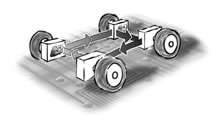Tooling up for tomorrow's clever cars

Cars are becoming more complex, with a range of advanced features we could hardly have imagined a few years ago made possible by sophisticated software-driven electronics. The downside is, with more to go wrong, more is going wrong, but European researchers have developed an antidote: a new computer language.
The average new car coming off the production line today has the same amount of electronic systems as a commercial airliner did two decades ago. Hard to accept perhaps, but true if auto-makers are to be believed.
Growth in automotive embedded systems (software and electronics) has been exponential since the early 1990s and the trend is predicted to continue. In 2002, electronic parts comprised 25 percent of a vehicle’s value – by 2015, car manufacturers predict this will hit 40 percent.
But the more electronic systems are added, the more they contribute to vehicle breakdowns and recalls. Researchers on the European ATESST project say a substantial share of vehicle failures today can be directly attributed to embedded systems, and field data indicates this share is increasing by several percent a year. This will reach unacceptable levels if no preventative action plan is put in place.
However the EU-funded, two-year project, which comes to an end when it presents its findings at a workshop in Brussels on 3 March this year, has developed an Architecture Description Language (ADL) aimed at improving methodology to handle component failures and avoid design flaws.
Binding them all
“New tools are needed to do a job which is becoming ever more complex,” says project coordinator Henrik Lönn. “The many components which go into vehicles are being made by a host of manufacturers, often using different processes and working to different standards.”
A common language at the top level is needed to bind them together, he says.
There have been a number of important initiatives, including the European-developed AUTOSAR standard, which is used by many component suppliers and is on its way to becoming a de facto international standard. Also in common usage are off-the-shelf UML2 modelling tools which are not specific to the auto industry.
“But this is still not enough,” he stresses. “What we have developed is an industry-specific system which works with these other standards and dictates what part of the system is performing what function, and makes sure the different components will work together.”
The problem is, despite the huge strides in electronics, until now not enough attention has been paid to the big picture. When the manufacturer gets a component from a supplier, no matter how sophisticated it might be, it comes with a text file which describes the system for the manufacturer’s engineers.
The EAST-ADL2 language the ATESST project has been developing enables the computer modelling of systems. Instead of the old-fashioned text file, a supplier can now provide a computer model of his system to the manufacturer who can then immediately integrate it into the overall design.
“What this does is to give the manufacturer a complete picture at a much earlier point in proceedings than is possible at the moment,” says Lönn. “You don’t have to wait for all the electronics and software to be ready and assembled, but can do your analysis at a much earlier stage.”
Clean, green mean machines
With a holistic view available much earlier than was previously possible, late-phase integration – where failure is both common and costly – is avoided and the chance of design errors, which are felt by car buyers, is minimised.
“Complex programs, like active safety functions, involve many systems and components. But we are at the stage now where it is becoming difficult to improve them without first improving our methodology, which is the purpose of EAST-ADL2.”
As well as the economic imperative to develop the new methodology, pressure will also come in the form of a new standard, ISO26262, controlling improvements in all the safety aspects of vehicles.
“This standard will put stringent requirements on the development of safety systems which means manufacturers will have to be more rigorous. Having the EAST-ADL2 language to work with will make this possible,” says Lönn.
“There is also pressure to build more environmentally-friendly cars and, to get the best environmental performance, optimised systems which are integrated and work properly together are needed,” he says.
With the development work over, the challenge now is to get the auto industry to accept EAST-ADL2 as a de facto standard. But the advantages to everybody are so obvious Lönn feels they will be adopted in one form or another. Indeed, he believes concepts from the project provide the basis for vehicles that are safer, greener, more fuel efficient, more reliable and more intelligent than would have been thought possible just a few short years ago.
Source: ICT Results





















